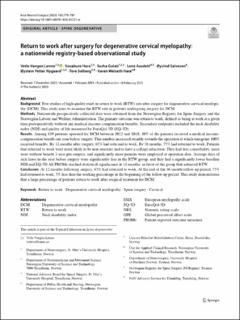| dc.contributor.author | Lønne, Vetle Vangen | |
| dc.contributor.author | Hara, Sozaburo | |
| dc.contributor.author | Gulati, Sasha | |
| dc.contributor.author | Aasdahl, Lene | |
| dc.contributor.author | Salvesen, Øyvind Olav | |
| dc.contributor.author | Nygaard, Øystein Petter | |
| dc.contributor.author | Solberg, Tore | |
| dc.contributor.author | Hara, Karen Walseth | |
| dc.date.accessioned | 2024-02-05T13:13:03Z | |
| dc.date.available | 2024-02-05T13:13:03Z | |
| dc.date.created | 2023-03-08T14:10:56Z | |
| dc.date.issued | 2023 | |
| dc.identifier.citation | Acta Neurochirurgica. 2023, 165 779-787. | en_US |
| dc.identifier.issn | 0001-6268 | |
| dc.identifier.uri | https://hdl.handle.net/11250/3115651 | |
| dc.description.abstract | Background
Few studies of high quality exist on return to work (RTW) rate after surgery for degenerative cervical myelopathy (DCM). This study aims to examine the RTW rate in patients undergoing surgery for DCM.
Methods
Nationwide prospectively collected data were obtained from the Norwegian Registry for Spine Surgery and the Norwegian Labour and Welfare Administration. The primary outcome was return to work, defined as being at work at a given time postoperatively without any medical income-compensation benefits. Secondary endpoints included the neck disability index (NDI) and quality of life measured by EuroQol-5D (EQ-5D).
Results
Among 439 patients operated for DCM between 2012 and 2018, 20% of the patients received a medical income-compensation benefit one year before surgery. This number increased steadily towards the operation at which timepoint 100% received benefits. By 12 months after surgery, 65% had returned to work. By 36 months, 75% had returned to work. Patients that returned to work were more likely to be non-smokers and to have a college education. They had less comorbidity, more were without benefit 1-year pre-surgery, and significantly more patients were employed at operation date. Average days of sick leave in the year before surgery were significantly less in the RTW group, and they had a significantly lower baseline NDI and EQ-5D All PROMs reached statistical significance at 12 months, in favor of the group that achieved RTW.
Conclusion
At 12 months following surgery, 65% had returned to work. At the end of the 36-month follow-up period, 75% had returned to work, 5% less than the working percentage in the beginning of the follow-up period. This study demonstrates that a large percentage of patients return to work after surgical treatment for DCM. | en_US |
| dc.language.iso | eng | en_US |
| dc.publisher | Springer | en_US |
| dc.rights | Navngivelse 4.0 Internasjonal | * |
| dc.rights.uri | http://creativecommons.org/licenses/by/4.0/deed.no | * |
| dc.title | Return to work after surgery for degenerative cervical myelopathy: a nationwide registry-based observational study | en_US |
| dc.title.alternative | Return to work after surgery for degenerative cervical myelopathy: a nationwide registry-based observational study | en_US |
| dc.type | Peer reviewed | en_US |
| dc.type | Journal article | en_US |
| dc.description.version | publishedVersion | en_US |
| dc.source.pagenumber | 779-787 | en_US |
| dc.source.volume | 165 | en_US |
| dc.source.journal | Acta Neurochirurgica | en_US |
| dc.identifier.doi | 10.1007/s00701-023-05521-w | |
| dc.identifier.cristin | 2132413 | |
| cristin.ispublished | true | |
| cristin.fulltext | original | |
| cristin.qualitycode | 1 | |

